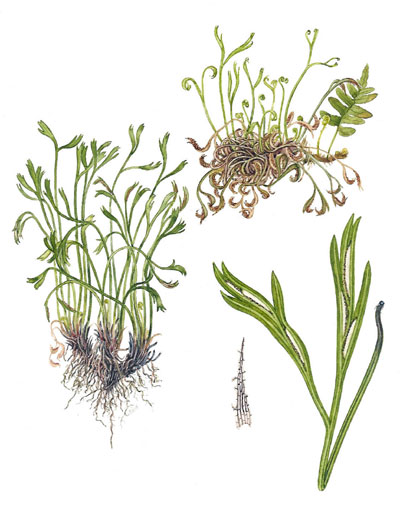| Asplenium septentrionale | ||
Forked spleenwort | ||
|
Etymology
Latin: Septentrionale means north. ``From cold
septentrion blasts.'' --Milton.
Description
Rhizome: erect, much branched to produce dense many-stemmed tufts or mats bearing numerous crowded leaves, scales clathrate, dark reddish brown to black throughout, narrowly deltate, to 4 mm.
Frond: 15 cm high by 1 cm wide, evergreen, monomorphic or nearly so, blade/stipe ratio: 1:3 to 1:5. Stipe: dark reddish brown at base, fading to green upwards, small hairs at base, otherwise glabrous, vascular bundles: 2 C-shaped, back to back, uniting to 1 upwards to an X-shape . Blade: forking is the term most commonly used here, linear, but no simple term is really satisfactory, forking 1or 2 times into narrow segments, cleft at the tips, leathery, glabrous. Pinnae: none in the usual sense; margins entire, sometimes toothed at the tips; veins free, forking. Sori: linear, parallel, alternating irregularly across the midrib, indusium: thin, flap-like, often covered during maturation, on one side of the sorus, opening towards the midrib, maturity: midsummer to early fall. Culture
Habitat: open sites, various substrates, surviving dessication.
Distribution: northern Europe, mountains of central Europe, elsewhere in Asia and North America scattered, often rare.
Hardy to -30°C, USDA Zone 4.
Distinctive Characteristics
a grass-like fern, hard to find
Synonyms
Acrostichum septentrionale Linnaeus |
|
|
